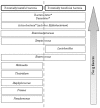Prebiotics from marine macroalgae for human and animal health applications
- PMID: 20714423
- PMCID: PMC2920542
- DOI: 10.3390/md8072038
Prebiotics from marine macroalgae for human and animal health applications
Abstract
The marine environment is an untapped source of bioactive compounds. Specifically, marine macroalgae (seaweeds) are rich in polysaccharides that could potentially be exploited as prebiotic functional ingredients for both human and animal health applications. Prebiotics are non-digestible, selectively fermented compounds that stimulate the growth and/or activity of beneficial gut microbiota which, in turn, confer health benefits on the host. This review will introduce the concept and potential applications of prebiotics, followed by an outline of the chemistry of seaweed polysaccharides. Their potential for use as prebiotics for both humans and animals will be highlighted by reviewing data from both in vitro and in vivo studies conducted to date.
Keywords: human and animal health; marine macroalgae; polysaccharides; prebiotics.
Figures








References
-
- Gonzalez del Val A, Platas G, Basilio A, Cabello A, Gorrochategui J, Suay I, Vicente F, Portillo E, Jimenez del Rio M, Reina GG, Pelaez F. Screening of antimicrobial activities in red, green and brown macroalgae from Gran Canaria (Canary Islands, Spain) Int. Microbiol. 2001;4:35–40. - PubMed
-
- Yuan YV, Walsh NA. Antioxidant and antiproliferative activities of extracts from a variety of edible seaweeds. Food Chem. Toxicol. 2006;44:1144–1150. - PubMed
-
- Chandini SK, Ganesan P, Bhaskar N. In vitro antioxidant activities of three selected brown seaweeds of India. Food Chem. 2008;107:707–713.
-
- Kang JY, Khan MNA, Park NH, Cho JY, Lee MC, Fujii H, Hong YK. Antipyretic, analgesic, and anti-inflammatory activities of the seaweed Sargassum fulvellum and Sargassum thunbergii in mice. J. Ethnopharmacol. 2008;116:187–190. - PubMed
-
- Pushpamali WA, Nikapitiya C, De Zoysa M, Whang I, Kim SJ, Lee J. Isolation and purification of an anticoagulant from fermented red seaweed Lomentaria catenata. Carbohydr. Polym. 2008;73:274–279.
Publication types
MeSH terms
Substances
LinkOut - more resources
Full Text Sources
Other Literature Sources
